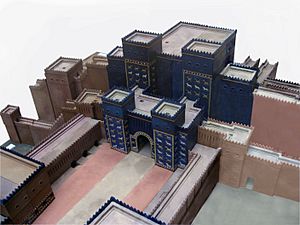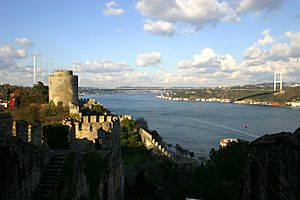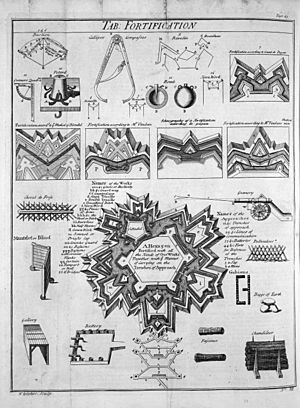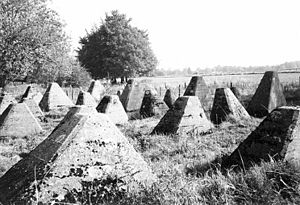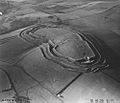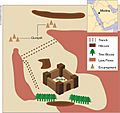Fortification facts for kids
Fortifications are military buildings and structures made for defense during wars. People have been building defensive works for thousands of years. Over time, their designs have become much more complex. The word "fortification" comes from the Latin words fortis (meaning "strong") and facere (meaning "to make").
Many military places are called forts, even if they are not always heavily protected. Larger forts can be called fortresses. The word fortification can also mean the act of making an area stronger with defensive structures. City walls are a type of fortification, but they are not usually called fortresses.
The last big system of fortifications ever built was the Atlantic Wall.
Contents
History of Fortifications
Ancient Defenses
From ancient times, walls were very important for many cities. Uruk in ancient Sumer (in Mesopotamia) is one of the oldest known cities with walls. The Ancient Egyptians also built strongholds along the Nile Valley to protect against invaders. Many old fortifications were made from mud brick. Today, these often look like simple dirt mounds to archaeologists.
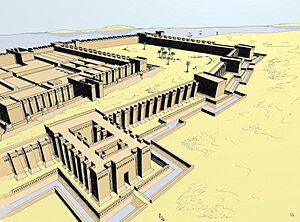
The Assyrians used many workers to build new palaces, temples, and strong defensive walls.
Some towns in the Indus Valley Civilization also had defenses. By about 3500 B.C., hundreds of small farming villages were in the Indus River area. Many of these had walls and planned streets. The stone and mud brick houses of Kot Diji were built behind huge flood walls and defensive barriers. This was because nearby communities often argued over good farming land. Mundigak (around 2500 B.C.) in today's southeast Afghanistan had defensive walls and square towers made of sun-dried bricks.
Babylon was one of the most famous ancient cities. This was especially true because of Nebuchadnezzar, who made the walls bigger and built the famous Ishtar Gate.
A few places were exceptions. For example, ancient Sparta and ancient Rome did not have walls for a long time. They chose to rely on their armies for protection instead. At first, these defenses were simple structures of wood and earth. Later, they were replaced by stone structures built without mortar.
In Central Europe, the Celts built large fortified settlements called oppida. Their walls seemed partly inspired by those in the Mediterranean Sea. These fortifications were always being made bigger and better.
In ancient Greece, large stone walls were built in Mycenaean Greece. An example is the ancient site of Mycenae, known for its huge stone blocks called 'cyclopean' walls. In the classical era of Greece, the city of Athens built a long set of parallel stone walls. These were called the Long Walls and reached their protected seaport at Piraeus.

Large, packed earth walls were built in ancient China starting from the Shang Dynasty (around 1600-1050 BC). The capital at ancient Ao had huge walls built this way. Although stone walls were built in China during the Warring States period (481-221 BC), most buildings did not switch to stone until the Tang Dynasty (618-907 AD).
The longest and most impressive fortification in China is the Great Wall. It began to be built during the Qin dynasty (221-207 BC). However, its current form was mostly built and improved by the Ming dynasty (1368-1644 AD). The large walls of Pingyao are one example. Also, the famous walls of the Forbidden City in Beijing were built in the early 15th century by the Yongle Emperor.
The Romans protected their cities with huge stone walls held together with mortar. The most famous are the Aurelian Walls of Rome and the Theodosian Walls of Constantinople. Parts of these walls still exist today. Other remains include city gates like the Porta Nigra in Trier.
Hadrian's Wall was built by the Roman Empire across what is now northern England. This happened after Roman Emperor Hadrian (AD 76–138) visited in AD 122.
Medieval Fortifications
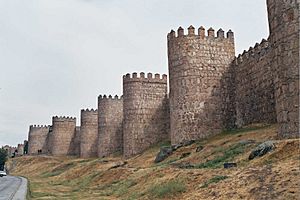
Roman forts and hill forts were the main types of defenses before castles in Europe. Castles started to appear in the 9th century in the Carolingian Empire.
In the Early Middle Ages, some towns grew around castles. These cities were rarely protected only by simple stone walls. More often, they had both walls and ditches. From the 12th century AD, hundreds of towns of all sizes were started across Europe. Many of them quickly gained the right to build fortifications.
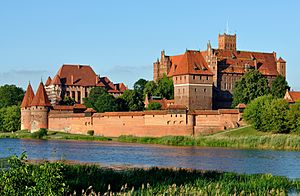
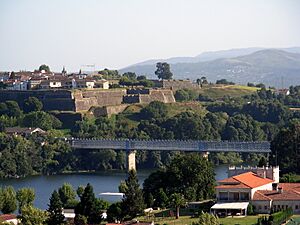
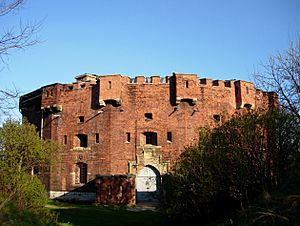

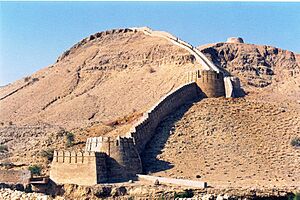
Starting new towns was a key way to expand territory. Many cities, especially in eastern Europe, were founded for this reason during the period of Eastern Colonisation. These cities are easy to spot because of their regular layout and large market squares. The defenses of these settlements were constantly improved to match the latest military developments.
During the Renaissance, the Venetians built huge walls around cities that were threatened by the Ottoman Empire. The best examples are in Nicosia (Cyprus) and Chania (Crete), and they are still standing today.
Early Modern Fortifications
Medieval-style fortifications became mostly useless when cannons appeared on battlefields in the 14th century. Fortifications in the age of gunpowder changed a lot. They became much lower structures with more ditches and earth ramparts. These new designs could absorb and spread the force of cannon fire. Walls that were directly hit by cannons were very weak. So, they were built lower, often sunk into ditches with earth slopes in front.
This new design focused on the geometry of the fortification. It allowed defensive cannons to have overlapping firing zones. This way, they could cover all ways to reach the lower, more vulnerable walls.
You can see how this new style of fortification developed in forts like Sarzanello in North West Italy. It was built between 1492 and 1502. Sarzanello has both medieval-style walls with towers and also an angular gun platform. This platform protected one of the main walls and was safe from side attacks from the fort's towers.
Fortifications also became deeper. They had protected areas for defensive cannons. This allowed them to fight against attacking cannons from a distance and stop them from firing directly at the vulnerable walls.
The result was star-shaped fortifications with many layers of defenses and bastions. Bourtange, shown in the image, is a great example. There are also many fortifications from this time in the Nordic countries and in Britain. Good examples are the defenses of Berwick-upon-Tweed and the harbor archipelago of Suomenlinna at Helsinki.
19th Century Fortifications
When explosive shells arrived in the 19th century, fortifications changed again. Star forts from the cannon era did not stand up well to high explosives. The complex setup of bastions and firing lines for defending cannons could be quickly destroyed by explosive shells.
Even worse, the large open ditches around these forts were a key part of their defense. These ditches were very vulnerable to explosive shells.
In response, military engineers developed the polygonal style of fortification. The ditch became very deep and had straight, vertical sides. It was cut directly into the ground, forming the central fortified area that gives this style its name.
The ditch was wide enough to stop attacking troops but narrow enough to be a hard target for enemy shells. It was protected by fire from defensive blockhouses built in the ditch. There were also firing positions cut into the outer face of the ditch itself.
The fort's shape became very low. Outside the ditch, there was a gently sloping open area to remove any cover for enemy forces. The fort itself presented a very small target for enemy fire. The entrance became a sunken gatehouse inside the ditch. You reached it by a curving ramp that led to a rolling bridge, which could be pulled back into the gatehouse.
However, traditional fortifications were still used by European armies fighting in colonies in Africa. They were used against lightly armed local attackers. A small number of defenders in a fort that could not be damaged by old weapons could hold out against many enemies. The only limit was how much ammunition they had.
Much of the fort moved underground. Deep passages and tunnels connected the blockhouses and firing points in the ditch to the main fort. Magazines (places to store ammunition) and machine rooms were deep underground.
However, the guns were often placed in open areas and only protected by a low wall (a parapet). This was to keep the fort's profile low. Also, experience showed that guns in closed casemates (armored rooms) could be put out of action by falling rubble if their casemates were destroyed.
20th and 21st Centuries Fortifications
Steel and concrete fortifications were common in the 19th and early 20th centuries. But new weapons since World War I have made large fortifications mostly useless. Only underground bunkers still offer some protection in modern wars. Many old fortifications were torn down in modern times. However, many still exist as popular tourist spots and important local landmarks.
Permanent fortifications became less useful for two main reasons:
- Artillery and air power became much stronger, faster, and could reach further. This meant that almost any target that could be found could be destroyed. The more a defender built up a fortification, the more powerful weapons an attacker would use to destroy it. By 1950, nuclear weapons could destroy entire cities and caused dangerous radiation. This led to the building of civilian nuclear air raid shelters. Later in the 20th century, special bombs called bunker busters were used against bunkers.
- The second weakness was that permanent fortifications were fixed in one place. Because of this, it was often easier to go around a fortification. With the rise of mobile warfare at the start of World War II, this became a good attacking choice. If a defensive line was too long to be completely bypassed, a huge attack could be focused on one part of the line to break through. After that, the rest of the line could be bypassed. This happened to many defensive lines built before and during World War II, like the Siegfried Line and the Stalin Line. The Maginot Line was different; it was designed to make the Germans go through Belgium, and it achieved its goal.
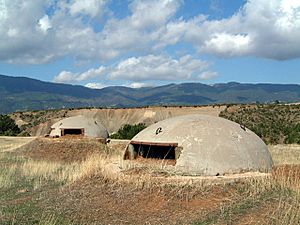
Instead, temporary defenses (field fortifications) became more important. Unlike the trench warfare of World War I, these defenses were more temporary. This was an advantage because they were less extensive and less obvious targets for the enemy.
If enough power was used to break through one point, the defenders there could retreat. The defensive line could then be set up again fairly quickly. Instead of a supposedly unbreakable line, these fortifications focused on defence in depth. This meant that as defenders were forced back or defeated, the lines of defenders behind them could continue the defense.
Because mobile attacks often tried to avoid the strongest points of a defensive line, these defenses were usually thin and spread out. However, the defense was not equally strong everywhere.
The strength of the defensive line in an area depended on how fast an attacking force could move through the terrain. This included both the ground the line was on and the land behind it that an attacker might want to reach. This was important for both the strategic value of the land and its defensive value.
This was possible because defensive tactics also became mobile. The dug-in defenses mainly had infantry and anti-tank guns. Defending tanks and tank destroyers were kept in mobile "Fire Brigades" behind the defensive line. If a big attack started at one point, mobile reinforcements would be sent to help that part of the line.
So, the defensive line could be relatively thin. Most of the defenders' fighting power was not in the line itself, but in the mobile reserves. A famous exception was the defensive lines at the Battle of Kursk during World War II. There, German forces purposely attacked the strongest part of the Soviet defenses to crush them completely.
The terrain being defended was very important. Open terrain where tanks could move quickly allowed fast advances into the defenders' rear areas, which was very dangerous. So, such terrain had to be defended at all costs.
Also, since the defensive line only had to hold out long enough for mobile reserves to arrive, terrain that did not allow fast advances could be held more weakly. This was because the enemy's advance would be slower, giving defenders more time to reinforce that point. For example, the Battle of Hürtgen Forest in Germany during the end of World War II shows how difficult terrain could help defenders.
After World War II, ICBMs were developed. These missiles could travel almost around the world. So, speed became a key feature of the strongest militaries and defenses. Missile silos were built, allowing missiles to be fired from the middle of a country to hit targets in another. Airplanes and aircraft carriers became major defensive and offensive weapons, leading to more airports and airstrips being used as fortifications. Mobile defenses could also be underwater, with nuclear submarines able to fire missiles. Some bunkers in the mid to late 20th century were buried deep inside mountains and large rocks, like Gibraltar and Cheyenne Mountain. On the ground, minefields have been used as hidden defenses in modern warfare. They often remain long after the wars have ended.
Demilitarized zones along borders are another type of fortification. They are passive, meaning they provide a safe space between potentially unfriendly armies.
Forts Today
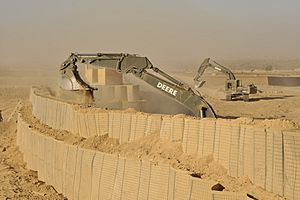
.
In modern times, "forts" often mean areas set aside by governments for a permanent military base. These places often do not have actual fortifications. They can be specialized for things like military living areas, administration, medical care, or intelligence. In the United States, "forts" specifically mean Army fortifications. Marine Corps fortifications are called camps.
However, some modern fortifications are still called forts. These are usually small, semi-permanent defenses. In city fighting, they are built by making existing buildings stronger, like houses or public buildings. In field warfare, they are often made of logs, sandbags, or wire cages filled with earth (called gabions).
Such forts are typically used only in smaller conflicts, like fighting against rebels or very small conventional wars. For example, the Indonesia–Malaysia confrontation saw the use of log forts for forward platoons and companies. This is because fixed forts above ground cannot survive modern direct or indirect fire weapons larger than mortars, RPGs, and small arms.
Forts in North America

In British North America, and later on the frontiers of the United States, before the 20th century, the word fort was increasingly used for any military base, no matter how well-fortified it was. Military forts in the American Old West during the American Indian Wars were often lightly protected enclosures with log or adobe walls. In many areas, fort meant any European or U.S. outpost, military or civilian, in an undeveloped region. Many of these outposts were simply trading posts or a mix of a trading post and an Army post.
Some famous U.S. military forts included Fort Laramie and Fort Bridger on the Emigrant Trail. Another was Bent's Fort on the Arkansas River.
Related pages
Gallery
-
Nakhal Fort, one of the best-preserved forts in Oman
-
A restored portion of the Great Wall of China
-
Fort Frederick Martello Tower in Kingston, Ontario at Royal Military College of Canada
-
Bare Island Fort in Botany Bay in a suburb called La Perouse, Sydney, Australia
Images for kids
-
Castillo San Felipe de Barajas, Colombia. Cartagena's colonial walled city and fortress were designated a UNESCO World Heritage Site.
-
Maiden Castle in 1935. The Iron Age hillfort was first built in 600 BC.
-
Early 20th century aerial photograph of the fortifications of Valletta, Malta which were built in the 16th and 17th centuries
-
Aerial photograph of Fort Vossegat, Utrecht, The Netherlands.
-
Han dynasty tomb brick showing gate towers
-
Han dynasty tomb brick showing watchtowers
-
Remains of a fortified village, Borġ in-Nadur, Malta. Borġ in-Nadur is a notable example of Bronze Age-fortifications.
-
Defensive wall of the ancient city of Dholavira, Gujarat 2600 BCE
-
The Great Wall of China near Jinshanling. The Great Wall was a series of fortifications built across the historical northern borders of China.
-
An American flag raised at the Fort Santiago, 1898. Fort Santiago was a citadel that was a part of the Intramuros, a walled city within Manilla.
-
Medieval defensive walls and towers in Szprotawa, Poland, made of field stone and bog iron.
-
John Smith's 1624 map of the fortifications of the Castle Harbour Islands and St. George's Harbour in Bermuda. Construction beginning in 1612, these were the first stone fortifications, with the first coastal artillery batteries, built by England in the New World.
-
Suomenlinna, a sea fortress from 18th century in Helsinki, Finland
-
The tunnels of Fort de Mutzig, German fortifications built in 1893. By the 19th century, tunnels were used to connect blockhouses and firing points in the ditch to the fort.
-
Gun emplacement in Fort Campbell, built in the 1930s. Due to the threat of aerial warfare, the buildings were placed at a distance from each other, making it difficult to find from the air.
-
Cheyenne Mountain Complex is an underground bunker used by North American Aerospace Defense Command. Cheyenne Mountain is an example of a mid-20th century fortification built deep in a mountain.
-
The Ozama Fortress in Santo Domingo, Dominican Republic is recognized by UNESCO for being the oldest military construction of European origin in the Americas.
See also
 In Spanish: Fortificación para niños
In Spanish: Fortificación para niños



